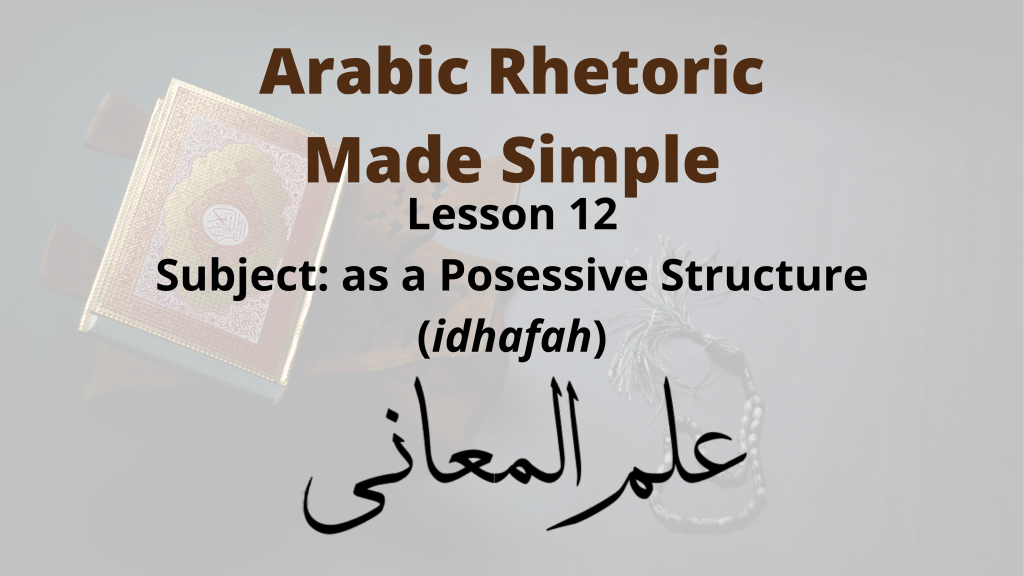
In this lesson on ilm ul-Balagha, we are going to talk about why you would make the subject of your sentence definite by إضافة.
You can learn all the basics of إضافة from the sub-topic of our grammar section entitled The Possessive Phrase
Types of Possessive Structures
Something the Arabic grammar article does not mention is that إضافة is of 2 types:
1. إضافة معنويّة (real idhafa)
To make it simple, this is basically the equivalent of “X of Y”
2. إضافة لفظيّة

This is where we use the “X of Y” structure for two nouns, but only as an abbreviation.
Sometimes you will find a governing agent مضاف towards it’s fa’il or maf’ool bihi, or mawsoof مضاف towards sifah, or sifah مضاف towards its mawsoof, mushabbah مضاف towards it’s mushabbah bihi, or mushabbah bihi مضاف towards its mushabbah. All of these are cases where a longer structure is being replaced by anإضافة -structure for brevity.
But when talking about the subject of a sentence and making it definite byإضافة , we are really just concerned with إضافة معنويّة (real idhafa)
1. More Concise than a Relative Clause
The first and primary reason you would express the subject of a sentence as an إضافة-structure is to reap the benefits of a relative clause (mawsool-sila structure), but in a more concise way.
Recall that we can use a mawsool-sila structure such as: the person who works for me, or we can be more concise and simply use an إضافة -structure and say: my employee.
The shorter version gives similar benefits to the ones that the longer version gives, except that it is shorter.
For example, the poet says:

Notice here that the poet can’t mention his lover by name or by pronoun, or demonstrative pronoun or even by ال (alif-laam). That is because none of these methods would tell us that she is his lover. He has to use a relative clause and say something like, “the one whom I love”. But in order to be more concise he opts to use an إضافة -structure, giving the same benefits but requiring less words.
2. Honour or Dishonour the مضاف
The second reason you would use an إضافة -structure is to honour or dishonour the مضاف.
For example: The office of the CEO is off limits.
Because the CEO himself [the مضاف إليه] is well honoured, this lends esteem to the office [the مضاف] as well.
Similarly, we can say: The stocks of Enron are all yours.
Because Enron [the مضاف إليه] is a failure, this lends dishonour to the stocks [the مضاف] as well.
3. To Honour or Dishonour the مضاف إليه
The third reason you would use an إضافة structure is to honour or dishonour the مضاف إليه.
For example: If you are standing with a bunch of friends who are making fun of you, and suddenly a Maserati comes to pick you up, you would say: “Excuse me gentlemen, my ride (ride of mine) is waiting”.
Because the Maserati [the مضاف] is well esteemed, this lends honour to you [the مضاف إليه] as well.
Similarly, if a hunk-of-junk comes to pick you up, one of your friends can use a similar technique to dishonour you. For example: “His ride (ride of his) is here”.
4. To Honour or Dishonour Something Else
Finally, this technique can be used to honour or dishonour not the مضاف إليه or the مضاف, but something else.
For example: The President’s signature is in my book.
Here the subject is: The president’s signature. The مضاف being “his signature”, and the مضاف إليه part being “the president”.
It is true that the president [the مضاف إليه] is lending honour to the signature [the مضاف], but the real point is to honour my book, or even me myself. That is neither the مضاف nor the مضاف إليه.
- Proceed to next lesson: Subject as an Indefinite noun
- Return to index page: Intro to Ilm Ul-Ma’ani
- Start free lessons: Sign Up for Free Mini-class